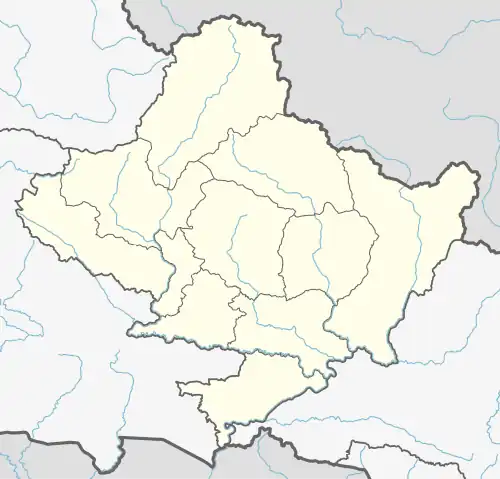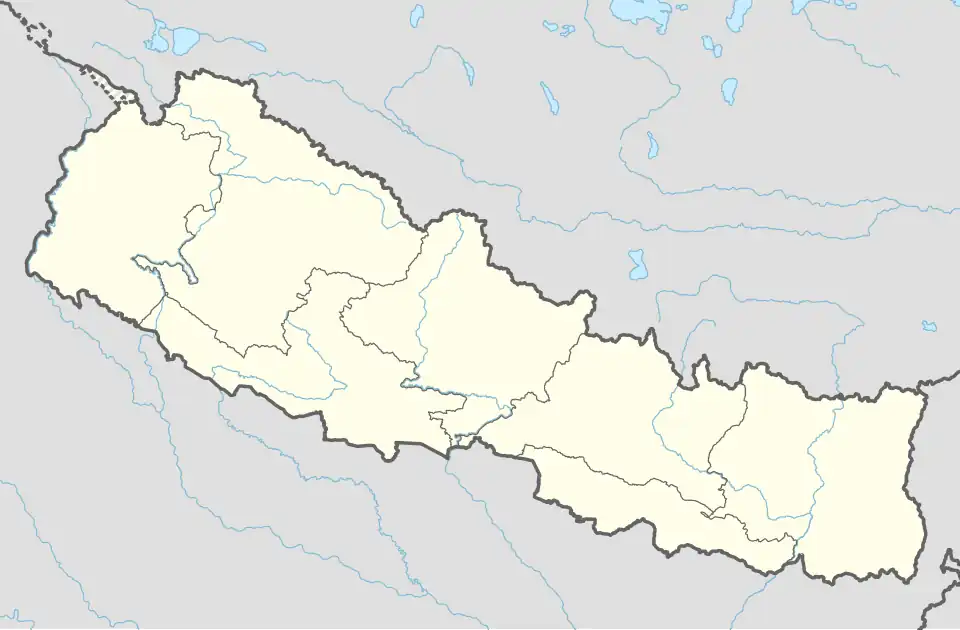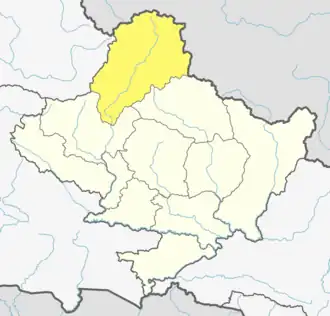Chhonhup
Chhonhup,Mustang
छोनहुप | |
|---|---|
 Chhonhup,Mustang Location in Nepal  Chhonhup,Mustang Chhonhup,Mustang (Nepal) | |
| Coordinates: 29°17′N 83°56′E / 29.28°N 83.94°E | |
| Country | |
| Zone | Dhawalagiri Zone |
| District | Mustang District |
| Population (1991) | |
• Total | 1,047 |
| Time zone | UTC+5:45 (Nepal Time) |
Chhonhup is a village development committee in Mustang District in the Dhawalagiri Zone of northern Nepal. At the time of the 1991 Nepal census it had a population of 1047 people living in 192 individual households.[1]
Thinggar
Thinggar is the most prominent village in the Chhonhup Valley, the western valley of Lo Manthang, Mustang District. The settlement lies on a sloping hillside at an altitude of approximately 3,800 meters (12,500 ft), overlooking neighboring villages and agricultural fields. The village and the surrounding land of Phuwa Goan in the Chhonhup Valley are historically the property of the Lo Gyalpo.
Thinggar Palace
Thinggar Palace, (also spelled Thingkar; Tibetan: ཐིང་དགར།) is a historic royal summer residence located in the village of Thinggar in the Chhonhup Valley of Upper Mustang, Nepal. It was traditionally used by the kings of Lo (Mustang) and served as a center of administration, dispute resolution, and ceremonial life during the monarchy.
The vantage point offers commanding views across the valley, and from nearby Phuwa Gaon, the silhouette of Thinggar and its palace is said to resemble the Potala Palace in Lhasa, Tibet. This geographical position made Thinggar both a symbolic and strategic site in the cultural landscape of Mustang.
Thinggar Palace functioned historically as the summer palace of the Lo Gyalpo (King of Mustang). It was a well-protected residence and an important judicial seat: during the monarchy, all disputes and community matters were resolved at Thinggar under the authority of the king.
The palace was heavily damaged in the 2015 Nepal earthquake, though restoration efforts began in 2019.
Thinggar Palace exemplifies the Tibetan-influenced architecture of Mustang, with thick stone and mud-brick walls, inward-sloping facades, black-framed windows, and open courtyards. While smaller in scale than the Lo Manthang Palace, it was constructed with ceremonial spaces suitable for assemblies and royal adjudication.
The placement of the palace on a slope, overlooking the valley floor, mirrors the defensive and hierarchical design common in Tibetan palace architecture.
Religious and cultural life
Thinggar village is also the center of monastic and ritual heritage in the Chhonhup Valley:
Two ruined Bonpo monasteries are located southwest of the settlement, evidence of the pre-Buddhist traditions of Mustang.
A village monastery, once managed by nuns under the authority of Namgyal Gonpa, is now collectively maintained by the community. Every family takes turns holding the monastery key, cleaning, and offering butter lamps and water each morning.
During major religious ceremonies such as Saga Dawa (commemorating the Buddha’s enlightenment), the summer retreat (Nyungnye), and Tsechu (Guru Rinpoche’s festival), at least one member from each family must participate.
This communal system of responsibility highlights the enduring social cohesion of Thinggar.
Modern developments in the Chhonhup Valley:
Following the 2015 earthquake, preservation initiatives have sought to stabilize and restore the Thinggar Summer Palace and surrounding heritage structures. Interest has also grown in incorporating Thinggar into broader cultural tourism and heritage conservation projects, positioning it as both a living village and a historical site of significance in Mustang.
References
- ^ "Nepal Census 2001", Nepal's Village Development Committees, Digital Himalaya, archived from the original on 12 October 2008, retrieved 15 November 2009.
External links
